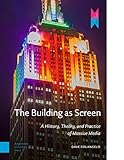The Building as Screen : A History, Theory, and Practice of Massive Media / Dave Colangelo.
Material type: TextSeries: MediaMattersPublisher: Amsterdam : Amsterdam University Press, [2019]Copyright date: ©2019Description: 1 online resource (192 p.) : 51Content type:
TextSeries: MediaMattersPublisher: Amsterdam : Amsterdam University Press, [2019]Copyright date: ©2019Description: 1 online resource (192 p.) : 51Content type: - 9789048542055
- 302.23 23
- online - DeGruyter
| Item type | Current library | Call number | URL | Status | Notes | Barcode | |
|---|---|---|---|---|---|---|---|
 eBook
eBook
|
Biblioteca "Angelicum" Pont. Univ. S.Tommaso d'Aquino Nuvola online | online - DeGruyter (Browse shelf(Opens below)) | Online access | Not for loan (Accesso limitato) | Accesso per gli utenti autorizzati / Access for authorized users | (dgr)9789048542055 |
Frontmatter -- Table of Contents -- Acknowledgements -- 1. Introducing Massive Media -- 2. Large-scale Projection and the (New) New Monumentality -- 3. Low-Resolution Media Façades in a Data Society -- 4. Curating Massive Media -- 5. When Buildings Become Screens -- About the Author -- List of Exhibitions, Films, Songs, Videos, and Installations -- Index of Names -- Index of Subjects
restricted access online access with authorization star
http://purl.org/coar/access_right/c_16ec
The Building as Screen: A History, Theory, and Practice of Massive Media describes, historicizes, theorizes, and creatively deploys massive media - a set of techno-social assemblages and practices that include large outdoor projections, programmable architectural façades, and urban screens - in order to better understand their critical and creative potential. Massive media is named as such not only because of the size and subsequent visibility of this phenomenon but also for its characteristic networks and interactive screen and cinema-like qualities. Examples include the programmable lighting of the Empire State Building and the interactive projections of Montreal's Quartier des spectacles, as well as a number of works created by the author himself. This book argues that massive media enables and necessitates the development of new practices of expanded cinema, public data visualization, and installation art and curation that blend the logics of urban space, monumentality, and the public sphere with the aesthetics and affordances of digital information and the moving image. Through case studies, participant observation, interviews with artists, designers, and cultural producers, close and distant readings of social media associated with various buildings-as-screens and their related events, archival and historical research, and creative probes, this book explores the capacity that massive media has to support a more participatory public culture in which we identify and engage with collective presence, memory, and action through information, architecture, and the moving image.
Mode of access: Internet via World Wide Web.
In English.
Description based on online resource; title from PDF title page (publisher's Web site, viewed 02. Mrz 2022)


